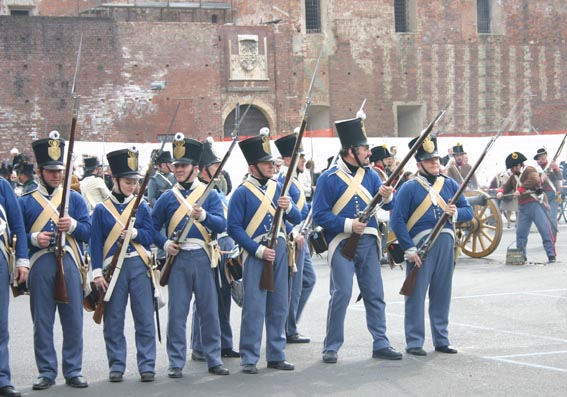The movement on which such great hopes were set was to begin in the kingdom of Naples in the spring of 1820.

The concession of the hard-won Spanish Constitution in the month of March encouraged the Neapolitans to believe that they might get a like boon from their own King if they directed all the forces at their command to this single end.
To avoid being compromised, they sought rather to dissociate themselves from the patriots of other parts of Italy than to co-operate with them in an united effort.below the italians of the pro austrian regiment estense

The Carbonari of the Neapolitan kingdom, who were the entire authors of the revolution, which, after many unfortunate delays, broke out on the 1st of July, had good cause for thinking that they were in a position to dictate terms; the mistake they made was to suppose that a charter conceded by a Bourbon of Naples could ever be worth the paper on which it was written.
Not only among the people, but in the army the Carbonari had thousands of followers on whom they could rely, and several whole regiments were only waiting their orders to rise in open revolt.
The scheme was to take possession of the persons of the King and the royal family, and retain them as hostages till the Constitution was granted. Such extreme measures were not necessary.
The standard of rebellion was raised at Monteforte by two officers named Morelli and Silvati, who had brought over a troop of cavalry from Nola, and by the priest Menechini.
In all Neapolitan insurrections there was sure to be a priest; the Neapolitan Church, much though there is to be laid to its account, must be admitted to have frequently shown sympathy with the popular side.
Menechini enjoyed an immense, if brief, popularity which he used to allay the anger of the mob and to procure the safety of obnoxious persons. The King sent two generals and a body of troops against the Chartists, but when the Carbonari symbols were recognised on the insurgent flags, the troops showed such clear signs of wishing to go over to the enemy that they were quietly taken back to Naples.
The cry of 'God, the King, and the Constitution,' was taken up through the land; General Pepe, who had long been a Carbonaro in secret, was enthusiastically hailed as commander of the Chartist forces, which practically comprised the whole army.
The King was powerless; besides which, when pushed up into any corner people who do not mind breaking their word have a facility for hard swearing. On the 13th of July, Ferdinand standing at the altar of the royal chapel, with his hand on the Bible, swore to defend and maintain the Constitution which he had just granted.
If he failed to do so, he called upon his subjects to disobey him, and God to call him to account. These words he read from a written form; as if they were not enough, he added, with his eyes on the cross, and his face turned towards heaven: 'Omnipotent God, who with Thine infinite power canst read the soul of man and the future, do Thou, if I speak falsely, or intend to break my oath, at this moment direct the thunder of Thy vengeance on my head.'






A brilliant Bersaglieri model here by an Italian company depicting him at the first battle of Custoza. Below are some views and the local wine. If you want to go to the area most fought over as regards the Italian Wars of Independence then go to Custoza.Here is a good place to eat Trattoria del Colli. I'll be continuing this with some remarks about the battle but in a different post.






No comments:
Post a Comment